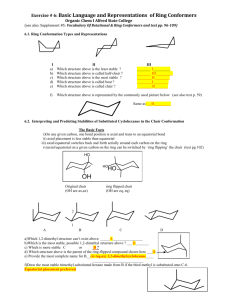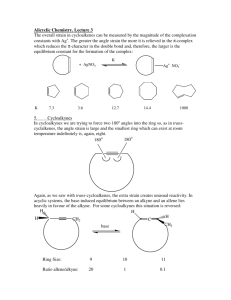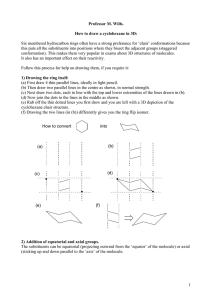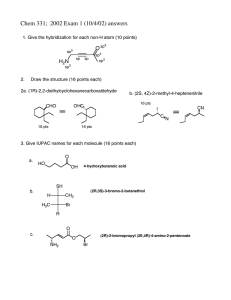5. 12
advertisement
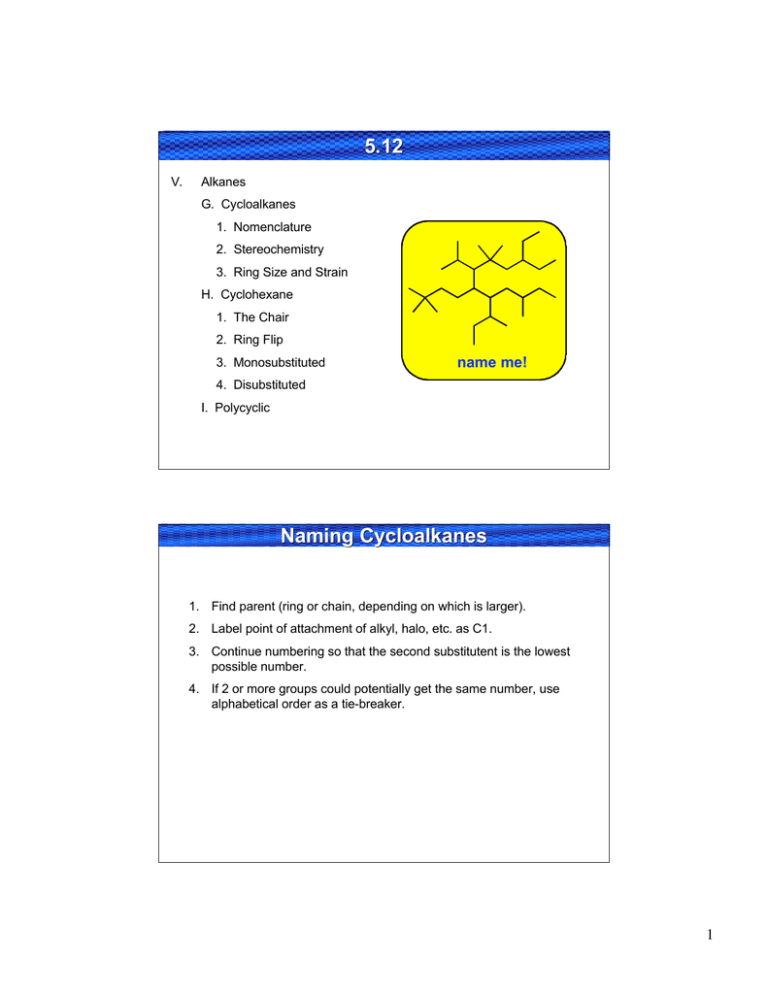
5.12 5.12 V. Alkanes G. Cycloalkanes 1. Nomenclature 2. Stereochemistry 3. Ring Size and Strain H. Cyclohexane 1. The Chair 2. Ring Flip 3. Monosubstituted name me! 4. Disubstituted I. Polycyclic Naming Cycloalkanes 1. Find parent (ring or chain, depending on which is larger). 2. Label point of attachment of alkyl, halo, etc. as C1. 3. Continue numbering so that the second substitutent is the lowest possible number. 4. If 2 or more groups could potentially get the same number, use alphabetical order as a tie-breaker. 1 Ring Inversion (Flipping) of C yclohexane Cyclohexan e half-chair boat 1.0 10.3 5.0 twist chair Courtesy of Jeffrey S. Moore, Department of Chemistry, University of Illinois at Urbana-Champaign. Used with permission. Adapted by Kimberly Berkowski. Atomic Motions Involved in Ring Inversion Courtesy of Jeffrey S. Moore, Department of Chemistry, University of Illinois at Urbana-Champaign. Used with permission. Adapted by Kimberly Berkowski. 2 Disubstituted Cyclohexane If 2 substituents are on cyclohexane the lowest energy conformation: a) Has both substituents equatorial (if possible) b) The group with the largest A value equatorial c) t-Bu is NEVER axial! Me 1 ax. 1 eq. versus 1 ax. 1 eq. Me 1,2-cis Me Me same energy Me Me 1,2-trans 2 ax. versus 2 eq. all equatorial preferred Me Me Me 1,3-cis Me Me Me Me Me 1,3-trans 2 ax. versus 2 eq. all equatorial preferred 1 ax. 1 eq. versus 1 ax. 1 eq. same energy Me Me Disubstituted Examples Et Et Et Me Me Me iPr Et Et iPr iPr Et tBu tBu But tBu H tBu But H tBu tBu 3 Polycyclic 1. Fused rings 2. Bridged rings H H conformationally locked H H cis-decalin can ring flip H H bicyclo[2.2.1]heptane 3. Spirocyclic rings (rare) H H trans-decalin can’t ring flip (locked!) bicyclo[4.4.0]decane spiro[4.4]nonane Me OH Draw me! Nomenclature: a. Prefix = bicyclo or spiro b. [Number] = number of carbons between bridgeheads, descending order c. Suffix = total carbons -ane H H HO H estradiol Substituted Cyclohexane Drawing Cyclohexane Chairs Steps 1–3: Draw three pairs of parallel lines as shown X equatorial: C–X bond anti to ring bonds axial: C–X bond gauche to two ring bonds (1) (2) (3) Steps 4–6: Draw equatorial bonds parallel to ring bonds in bold X (4) (5) (6) Steps 7,8: Draw axial bonds as vertical lines below and above ring. H H • This means that axial groups experience 1,3-diaxial interactions; "bump into" other axial groups. X • EQUATORIAL PREFERRED A-Values to Remember –X (7) (8) Ring Flip 6 4 2 3 6 4 2 5 1 5 3 1 • Interconverts equatorial and axial substituents. • Energetic barrier = 10 kcal/mol; occurs rapidly at room temperature. –CH3 –CH2CH3 –CH(CH3)2 –C(CH3)3 –CN –OH –Cl –Br A-Value 1.74 1.8 2.1 5.4 0.2 1.0 0.5 0.6 • A-Value = magnitude of equatorial preference 4
